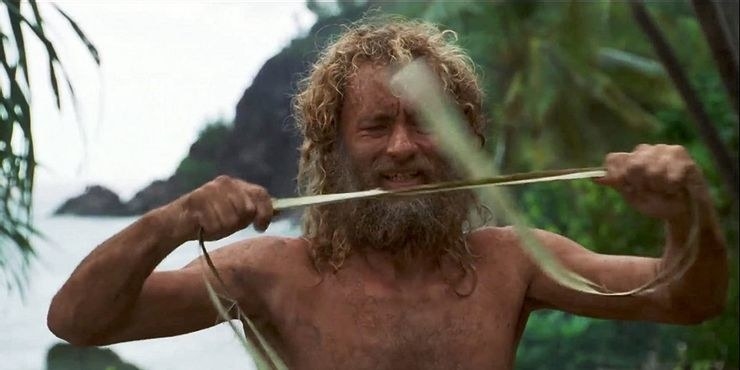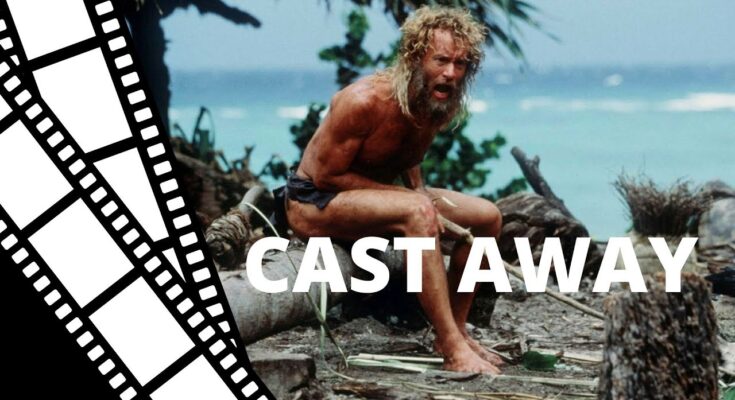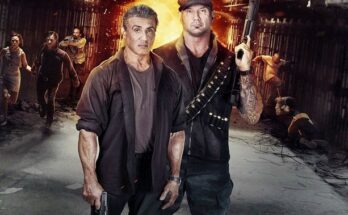Cast Away (2000)
“Cast Away” (2000), directed by Robert Zemeckis and starring Tom Hanks, is a powerful survival drama about isolation, perseverance, and the human spirit’s unyielding drive to endure. Both a physical and emotional journey, the film examines what happens when a man stripped of modern comforts must confront nature — and himself — in total solitude.
The story follows Chuck Noland (Tom Hanks), a systems engineer for FedEx whose life revolves around time, efficiency, and control. He travels constantly, ensuring that deliveries around the world run on schedule. His obsession with deadlines and order defines him, leaving little room for anything else — even his devoted girlfriend, Kelly Frears (Helen Hunt), with whom he shares a deep but time-constrained relationship.

Just before Christmas, Chuck is called away for an emergency business trip to Malaysia. On Christmas Eve, he and a small FedEx crew board a cargo plane across the Pacific. Mid-flight, disaster strikes when a violent storm causes the plane to crash into the ocean. Chuck barely escapes with his life, clinging to an inflatable life raft as the aircraft sinks into the depths. When dawn breaks, he finds himself alone, stranded on a remote, uninhabited island.

At first, Chuck’s struggle is frantic and desperate. He scavenges what he can from FedEx packages that wash ashore, using them to survive — ice skates for cutting, videotape for rope, and a volleyball, which he names Wilson, after the brand logo. As loneliness consumes him, Wilson becomes his only companion, a figment of his imagination that helps him retain his sanity and sense of humanity.

Chuck learns through trial and error how to live off the land — making fire, catching fish, collecting rainwater, and seeking shelter in a cave. His body transforms over time: he becomes lean, sunburned, and bearded, shedding the look of civilization for that of survival.
Years pass. Chuck marks time by carving notches on a cave wall and dreaming of Kelly, the life he left behind, and the world that may have forgotten him. He also discovers the body of a crew member who washed ashore; Chuck buries him and uses part of the wreckage as a sail later in his escape attempt.

Driven by a will to live and a desire to return to Kelly, Chuck eventually builds a makeshift raft using logs, rope, and the remnants of a portable toilet door that washed up from the wreckage. He launches into the open ocean, enduring storms, dehydration, and despair. After four years on the island, Wilson tragically drifts away during the journey, leaving Chuck utterly alone once more. His grief over losing his only “friend” highlights the depth of his loneliness — a testament to the human need for connection.
At last, Chuck is rescued by a passing cargo ship. When he returns home, he discovers how much time has passed — and how much has changed. Kelly, believing he was dead, has married another man and started a family. Though devastated, Chuck accepts her decision with grace and understanding. Their emotional farewell is tender and heartbreaking; she will always love him, but their lives have diverged.
In the film’s closing moments, Chuck stands at a rural crossroads — a literal and symbolic point of choice — unsure of where to go next. He looks down each road, contemplating his new beginning, carrying with him the wisdom and humility forged from his ordeal.
“Cast Away” is more than a survival story; it’s a profound meditation on isolation, adaptation, and the fragility of human life. Through Chuck’s transformation, the film asks: what truly sustains us when everything else is stripped away?
Tom Hanks delivers a tour-de-force performance, carrying nearly the entire film alone and earning an Academy Award nomination for Best Actor. With stunning direction, minimal dialogue, and haunting realism, Cast Away reminds audiences that survival is not just about enduring hardship — but rediscovering the will to live and start again.



